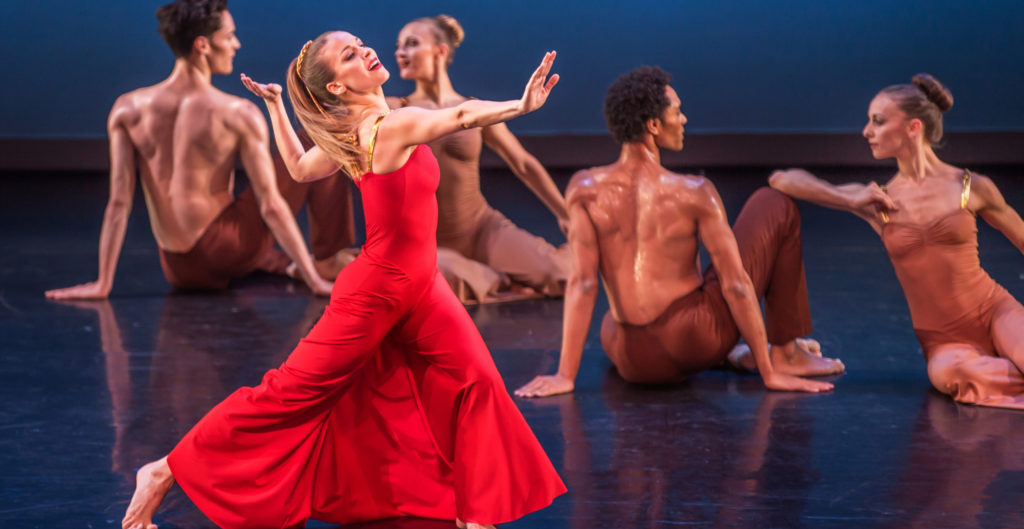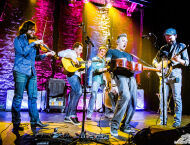Culture
 Anne O’Donnell (soloist) and the Martha Graham Dance Company in Martha Graham’s “Diversion of Angels.” // Photo: Brigid Pierce
Anne O’Donnell (soloist) and the Martha Graham Dance Company in Martha Graham’s “Diversion of Angels.” // Photo: Brigid Pierce
The EVE Project Celebrates Female Power and the Legacy of Martha Graham
March 3, 2020 @ 12:00am
Perhaps the most visionary dancer and choreographer of all time, Martha Graham is still revered by dancers and patrons of the arts alike for her innovative take on the art of movement. Her dynamic choreography and fearless approach to the world of dance continues to resonate – as does her feminist legacy. For Graham, dance was an art as much as a sport, but most importantly, it was a way to express the complexity of what it means to be a woman, in all forms, without ever speaking a word.
As the centennial of the 19th Amendment being passed falls upon us, those who share Graham’s legacy with the world and further her artistic vision thought her message would be the perfect way to commemorate this momentous anniversary. Spearheaded by Janet Eilber, creative director of Martha Graham Dance Company, and featuring contemporary female choreographers such as Pam Tanowitz, The EVE Project consists of some of Graham’s classic works paired with new choreography, performed with unmatched skill and athleticism by dancers from the Martha Graham Dance Company.
“In Untitled (Souvenir) Graham dancers inhabit a place of tensions and resolutions through a movement vocabulary which acknowledges past and present simultaneously,” says Tanowitz of her original choreography, premiering as part of this powerful, three-night event at the Kennedy Center, beginning this Thursday.
To fully understand Graham’s legacy, how this program communicates her genius, and the power of dance as a communicative medium, we spoke to Eilber before the dancers and choreographers make their way to D.C. in celebration of Graham, women gaining the right to vote and the power of dance.
On Tap: Can you tell me bit about your background and your role at the Martha Graham Dance Company?
Janet Eilber: I’m the creative director of the Martha Graham Dance Company. My leadership is focused on how we give our audiences more points of access to the Graham legacy. That includes a lot of things: we do a spoken introduction to all of our programs, like a museum’s audio tour, we use media and narration, we do contextual programming, which is where The EVE Project comes in. We’re curating programs under one theme. One of the most important things that has broadened the way people look at Martha Graham is the commissioning of new work, and that will certainly be in our program at the Kennedy Center.
How did The EVE Project come to be? What do you hope this night of dance communicates to its audiences?
I was looking for an opportunity to remind people that one of Martha’s most revolutionary techniques: the way she presented women onstage. She created women characters that were incredibly complex, as opposed to the two-dimensional maiden who wants a prince. No, she created characters who were flawed, ambitious, powerful, evil – the whole range.
She used them to do a complete psychological study, and she was revolutionary in the fact that she was choreographing the minds of these women: consciousnesses, their memories, flashbacks. She was able, through that technique she invented, to create characters that were dimensional and multifaceted.
People know the name Martha Graham, [but] they don’t always remember what she did. So when I choose a theme, I’m trying to open a door to that part of Martha’s legacy. So for the 19th Amendment, it seemed like the perfect time to line up this idea of the amazing women she put on the stage. And it also gave us the opportunity to commission new work from today’s top choreographers who happened to be female.
Tell me more about the variety of works The EVE Project will bring to the Kennedy Center later this week.
The works we’re bringing to the Kennedy Center are really at the center of Martha’s ideas about self-empowerment. We’re opening with a dance called Diversion of Angels.The first dance is all about love. There are three couples: a couple in yellow, which is flirtatious love; teenage couple in red, which is passionate love; and the couple in white enduring , spiritual love. Martha used to say this could be three women, but it really could be one woman at three different times in her life. So we’re showcasing that aspect of womanhood, and the evolution of your relationships with mortality and the world.
We’re closing the program with Chronicle, which is [showing] women as an instrument of force. It’s an anti war statement. She created it in 1936. She was concerned with the rise of fascism in Europe, and turned down the Nazis invitation to dance in Berlin at the Olympic Games. And she created this about a half hour [long] work in three sections where the power of women – the athleticism, determination and the message that they send with their bodies – just blows you away.
What makes dance such a powerful method of communication?
You connect with it viscerally and kinesthetically. At its best, it bypasses your intellect and you just feel it in your bones. The reason I think that happens in Martha’s theatre more than some others is that the kernel of her vocabulary, of the unique physical technique that she created, is body language. How anyone holds their body when they’re unhappy or when they’re euphoric or when they’re stressed. She studied human beings and borrowed the moves that we all recognize in ourselves and she theatricalized them. But of course, it’s not just sort acting, doing human poses on stage. That was her genius. She took that as a seed and then grew it into this incredibly visceral, powerful language.
The EVE Project takes place at the Kennedy Center from Thursday, March 5-7 with performances at 8 p.m. each night in the Eisenhower Theatre. Tickets begin at $25. For more on the work of Janet Eilber and the Martha Graham Dance Company, visit www.marthagraham.org. For more on the work of Pam Tanowitz, visit www.pamtanowitzdance.org.
The John F. Kennedy Center for the Performing Arts: 2700 F St. NW, DC; www.kennedy-center.org







